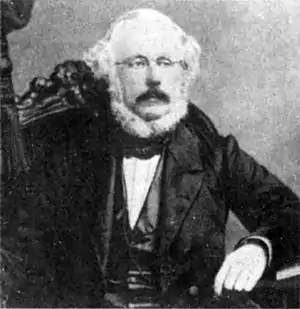Edward Harris (ornithologist)
Edward Harris (September 7, 1799 – June 8, 1863) was a farmer, horse breeder, philanthropist, naturalist, and ornithologist who accompanied John James Audubon on two of his expeditions to observe birds and mammals of America.[1] Harris was commemorated by Audubon in the common names of the Harris's hawk and the Harris's sparrow, and by John Cassin in the binomial of the buff-fronted owl, Aegolius harrisii.
Edward Harris | |
|---|---|
 | |
| Born | September 7, 1799 |
| Died | June 8, 1863 |
| Occupation | Farmer Horse breeder |
| Parent(s) | Edward Harris, Sr. (died 1822) |
Edward Harris introduced the Percheron horse to America in 1839 and established the first Percheron breeding line in the United States.[2][3]
Life
In 1798, Edward Harris, Sr. purchased a house and farm, located near the center of Moorestown, New Jersey, where Edward Harris, Jr. was born the following year.[3] After inheriting the property at his father's death in 1822, Edward Harris, Jr. lived there and farmed the land until 1849.[3]
He met the ornithologist John James Audubon in 1824 after which the two men became close friends, Harris providing Audubon with some financial assistance for the publication of Birds of America.
Harris took part in two of Audubon's expeditions: in the spring of 1837 in the Gulf of Mexico, and in 1843 along the Missouri River.
Edward Harris is buried at Trinity Episcopal Church in Moorestown, New Jersey.[4]
In popular culture
Edward Harris appeared in the alternate history short story Audubon in Atlantis by Harry Turtledove.
Footnotes
- Percheron Park
- Mischka, pp. 34-5
- Smith-Cadbury Mansion Courtesy of Moorestown Historical Society
- Find A Grave
References
- Mischka, Joseph (1991). The Percheron Horse in America. Heart Prairie Press. ISBN 0-9622663-5-3
- Purdy, James C. (1886). Moorestown, old and new: a local sketch. Printed by Percy J. Lovell, Moorestown, New Jersey.